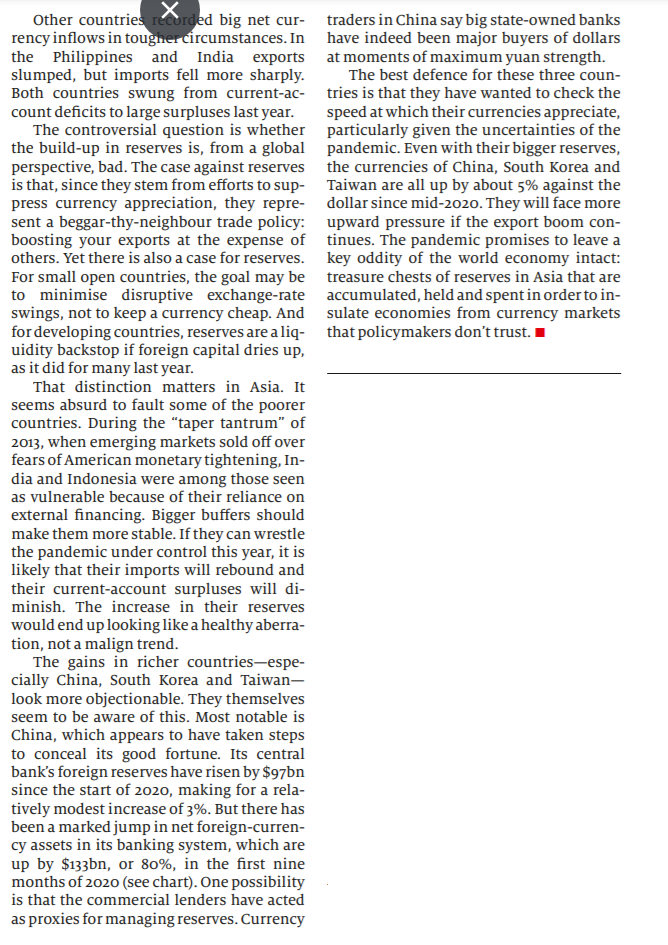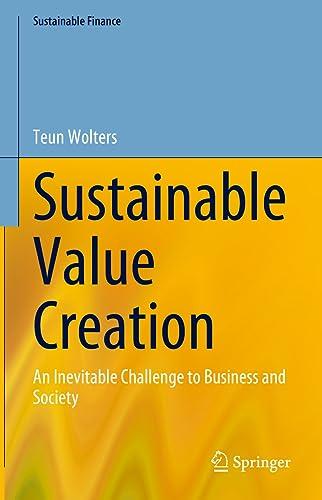Please summarize following article in financial term


Asian economies Power in reserves SHANGHAI Asia's soaring trade inflows put currency intervention in the spotlight T MIGHT SEEM cause for celebration. Tai- Iwan was already a standout economic performer in a pandemic-plagued world, and its good run, fuelled by semiconductor sales, is continuing. Orders for its exports rose by an eye-watering 49% in the first two months of 2021 compared with a year earlier, according to data released on March 22nd. There is just one snag: export strength has become awkward for officials in Taipei, for it attracts unwanted atten- tion. America's Treasury has already placed Taiwan on its "monitoring list" for coun- tries that manipulate their exchange rates and the boom only adds to the harsh glare. If it is any solace to Taiwan, it is far from alone in drawing such scrutiny. Across Asia foreign-exchange reserves-a good proxy for currency intervention-have jumped. Excluding China (where the data are trickier to interpret), reserves in the next ten largest Asian economies in- creased by about $410bn last year, the big- gest annual jump on record, according to calculations by The Economist. Some of the other countries are, like Taiwan, part of the Asian manufacturing complex which has benefited from resil- ient overseas demand for electronics and consumer goods amid covid-19 lockdowns. In Vietnam, for example, exports grew by 6.5% last year. With its currency, the dong, loosely pegged to the dollar, much of those trade receipts wound their way into official foreign-exchange reserves (the central bank issues dong to buy excess dollars from commercial banks at a quasi-fixed ex- change rate). Other countries recorded big net cur- traders in China say big state-owned banks rency inflows in tougher circumstances. In have indeed been major buyers of dollars the Philippines and India exports at moments of maximum yuan strength. slumped, but imports fell more sharply. The best defence for these three coun- Both countries swung from current-ac- tries is that they have wanted to check the count deficits to large surpluses last year. speed at which their currencies appreciate, The controversial question is whether particularly given the uncertainties of the the build-up in reserves is, from a global pandemic. Even with their bigger reserves, perspective, bad. The case against reserves the currencies of China, South Korea and is that, since they stem from efforts to sup- Taiwan are all up by about 5% against the press currency appreciation, they repre- dollar since mid-2020. They will face more sent a beggar-thy-neighbour trade policy: upward pressure if the export boom con- boosting your exports at the expense of tinues. The pandemic promises to leave a others. Yet there is also a case for reserves. key oddity of the world economy intact: For small open countries, the goal may be treasure chests of reserves in Asia that are to minimise disruptive exchange-rate accumulated, held and spent in order to in- swings, not to keep a currency cheap. And sulate economies from currency markets for developing countries, reserves are a liq- that policymakers don't trust. uidity backstop if foreign capital dries up, as it did for many last year. That distinction matters in Asia. It seems absurd to fault some of the poorer countries. During the "taper tantrum of 2013, when emerging markets sold off over fears of American monetary tightening, In- dia and Indonesia were among those seen as vulnerable because of their reliance on external financing. Bigger buffers should make them more stable. If they can wrestle the pandemic under control this year, it is likely that their imports will rebound and their current-account surpluses will di- minish. The increase in their reserves would end up looking like a healthy aberra- tion, not a malign trend. The gains in richer countriesespe- cially China, South Korea and Taiwan, look more objectionable. They themselves seem to be aware of this. Most notable is China, which appears to have taken steps to conceal its good fortune. Its central bank's foreign reserves have risen by $97bn since the start of 2020, making for a rela- tively modest increase of 3%. But there has been a marked jump in net foreign-curren- cy assets in its banking system, which are up by $133bn, or 80%, in the first nine months of 2020 (see chart). One possibility is that the commercial lenders have acted as proxies for managing reserves. Currency








